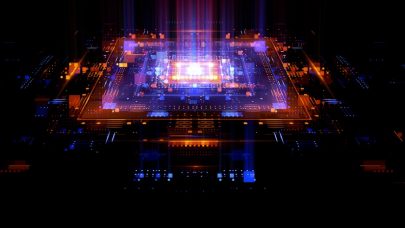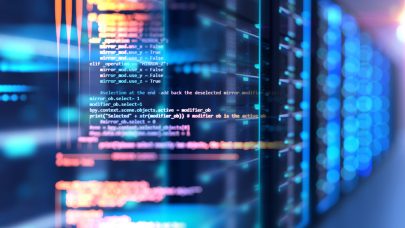LA MIRADA, Calif. and SAN FRANCISCO, March 1, 2024 — The High Performance Computing Program (HPCP) at CSU San Bernardino has been selected to receive the CENIC 2024 Innovations in Networking Award for Research Applications in recognition of its work supporting faculty who wish to avail themselves of all the National Research Platform (NRP) has to offer.
 The CENIC Innovations in Networking Awards recognize exemplary people, projects, and organizations that leverage high-bandwidth networking.
The CENIC Innovations in Networking Awards recognize exemplary people, projects, and organizations that leverage high-bandwidth networking.
“I am delighted to extend my heartfelt congratulations to the High Performance Computing Program,” said Louis Fox, CENIC’s Chief Executive Officer. “The dedication and efforts of all the honorees in advancing high-performance computing and research capabilities are truly inspiring.”
The NRP is a partnership of more than 50 institutions nationwide, led by researchers and cyberinfrastructure professionals at UC San Diego and is a national open-access, scalable cyberinfrastructure for research and education grown through the in-kind contributions of its user community. Thanks to the NRP, researchers and educators across California, the United States, and the world are able to store, transfer, and access vast amounts of information regardless of geographical distance.
Supporting a Broad Range of Big-Data Disciplines
While many of the most active heavy users are located at large research universities, the role of the High Performance Computing Program (HPCP) at CSU San Bernardino is particularly noteworthy in the rapid adoption and use of these resources at the California State University system. The HPCP and the collaborative work with the NRP that led to it is headed by Samuel Sudhakar, Chief Financial Officer and Vice President, Finance, Technology and Operations; Youngsu Kim, Professor of Mathematics and High-Performance Computing Faculty Fellow; and Dung Vu, Lead High-Performance Computing Analyst at CSU San Bernardino.
Sudhakar stated, “The High Performance Computing Program at CSUSB supported by the National Research Platform and CENIC has opened up tremendous opportunities for faculty-led innovation and research at our University. We are grateful for the collaboration we have with NRP and CENIC and the funding from NSF to grow and expand the HPC resources we provide our faculty.”
Sudhakar, Kim, Vu, and their team’s work has been pivotal in supporting faculty in their research endeavors and providing them with the tools and resources to access and manipulate vast amounts of data – crucial not only for researchers and educators across California and the US but also for international collaborations.
The High Performance Computing Program Faculty Showcase for 2023 may be viewed on YouTube. All the researchers in the showcase spoke highly of the value they place on the resources themselves as well as the individualized support received from the HPCP team.
Reconstructing a Virtual Archaeological Site in Egypt
One extraordinary example of a recent HPCP-supported project is Benson and Pamela Harer Fellow in Egyptology Dr. Kate Liszka’s and Robert and Frances Fullerton Museum of Art’s research Egyptologist and educator Bryan Kraemer’s interactive 3D model of a large archaeological site in southeastern Egypt, Wadi el Hudi, created from 91,000 still images.
With so many images and so much data to manage, as Kraemer says, “The scale of the data can sometimes outstrip our ability to process it.” For example, a site called Dihmit South provided 12,000 high-resolution photographs in only two days of examination. “That’s just not going to work properly on most of the machines we have available.”
Discovering, Manufacturing, and Deploying New Materials Faster: the Materials Genome Initiative
Many of the innovations we interact with and rely on – sensors, touchscreens, medical implants and medications, kitchen appliances, and much more – employ highly specialized materials that react to electricity, deformation, temperature, or even light in very precise ways. However, making and testing materials in order to determine their usefulness can be expensive and time-consuming. The ability to predict in advance whether a given material will exhibit one or more of these useful behaviors would save time and money and can enable researchers to design such materials from first principles and models.
Performing such calculations on these materials of course requires access to vast databases and processing power, and thanks to the resources and support provided by the HPCP, CSU San Bernardino’s Center for Advanced Functional Materials has already found promising candidate materials worth investigating.
Using Machine Learning to Predict and Treat Pediatric Sleep Apnea
Another HPCP-supported project makes use of large datasets from the Agency for Healthcare Research and Quality relating to pediatric obstructive sleep apnea. Thanks to the access and computing resources that they need to make use of these vast national datasets, the team of Benjamin Becerra, assistant professor at CSU San Bernardino’s Center for Health Equity, is working on developing predictive models for this disorder.
This work can be seriously hampered by what Becerra calls the “curse of dimensionality” – the amount of different types of data associated with each patient encounter. For each of the tens of millions of such records, the sex, age, race, and various diagnostic and billing codes only scratch the surface of the data that must be accounted for in their machine-learning models. It would be practically impossible to do this locally. Luckily, the team has access to the National Research Platform and JupyterLab notebooks.
These resources have also enabled students to participate more fully in this research, who would normally be using less powerful laptops or tablets incapable of handling such datasets locally.
Optimizing Traffic Monitoring Using Drones
One of the most potentially revolutionary uses of artificial intelligence and machine learning is in the real-time management of fleets of unmanned aerial vehicles, commonly known as drones. Environmental monitoring and data collection – especially in situations where fast response and decision-making are needed such as agricultural uses and disaster response – is a perfect example of how real-time routing of drones based on the data they provide can intersect deeply with big-data science, artificial intelligence, and machine learning, including their high-performance computing requirements.
Research performed by CSU San Bernardino’s Information and Decision Sciences Department focuses on mathematical models to optimally route and schedule fleets of drones in order to monitor and respond to traffic flow and emergency situations. A very small model with only a few drones can be manageable, but as the number of drones increases, such models quickly become cumbersome beyond the ability of ordinary computer resources; without the resources and support of the university’s HPCP, these calculations would be unmanageable.
About CENIC
CENIC connects California to the world—advancing education and research statewide by providing the world-class network essential for innovation, collaboration, and economic growth. This nonprofit organization operates the California Research and Education Network (CalREN), a high-capacity network designed to meet the unique requirements of over 20 million users, including the vast majority of K-20 students together with educators, researchers and others at vital public-serving institutions. CENIC’s Charter Associates are part of the world’s largest education system; they include the California K-12 system, California Community Colleges, the California State University system, California’s Public Libraries, the University of California system, Stanford, Caltech, USC, and the Naval Postgraduate School. CENIC also provides connectivity to leading-edge institutions and industry research organizations around the world, serving the public as a catalyst for a vibrant California.
Source: CENIC

































































